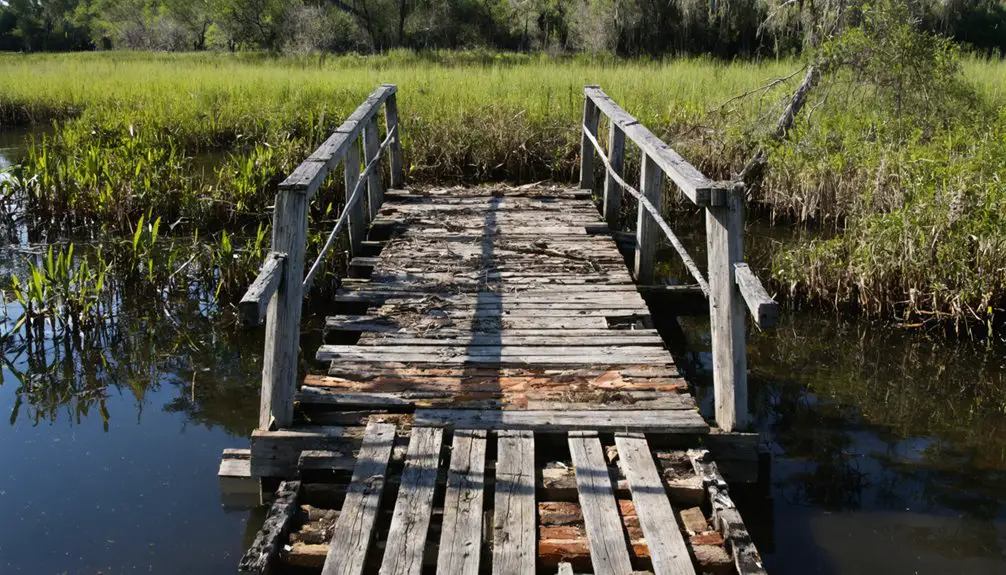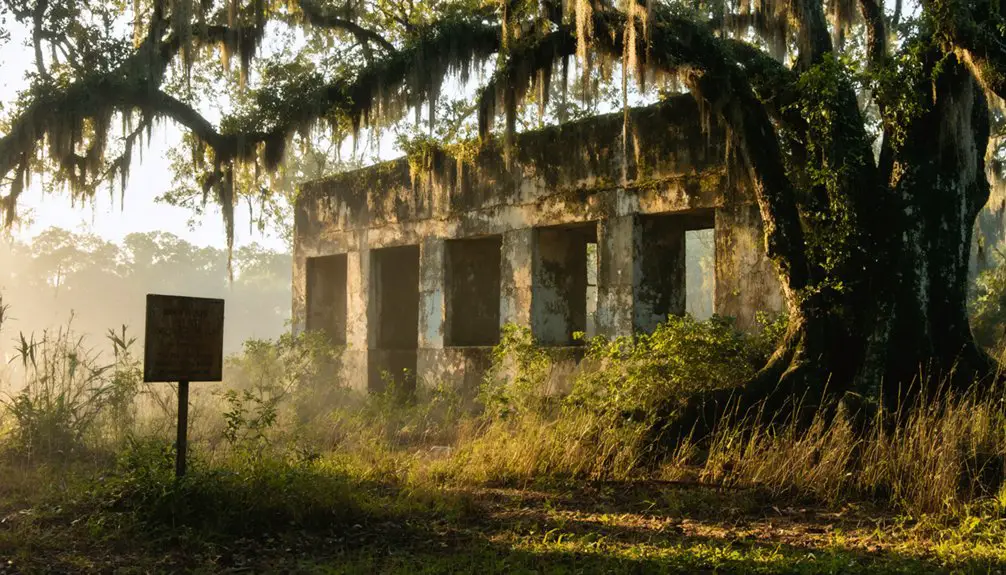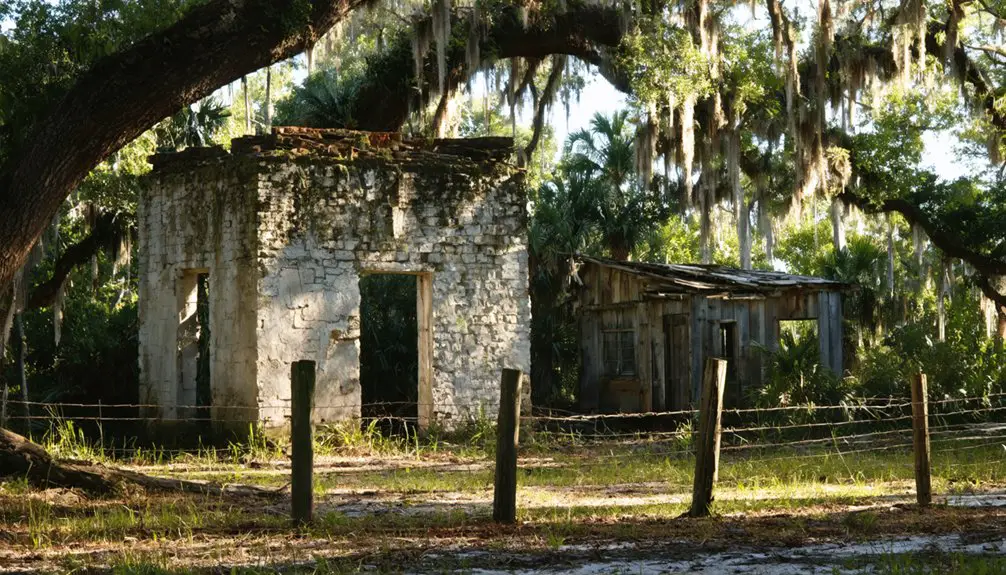You’ll find Fort Basinger’s remains along Florida’s Kissimmee River, where Colonel Zachary Taylor established this military outpost in 1837 during the Second Seminole War. The fort evolved from a strategic defense point into a bustling river trading settlement, featuring general stores, blacksmith shops, and a school for 150 students. After the Florida East Coast Railroad bypassed the town in 1915, Fort Basinger gradually declined, leaving behind rich military heritage and compelling frontier tales waiting to be discovered.
Key Takeaways
- Fort Basinger transformed from a military outpost into a thriving river trading settlement before declining into a ghost town by 1920.
- The town’s demise began when the Florida East Coast Railroad bypassed it in 1915, ending its importance as a river commerce hub.
- Only one historic homestead and the Basinger Cemetery remain from the original settlement that once had five stores and three blacksmiths.
- The ghost town’s peak included multiple hotels, stores, and a school for 150 students during the late 19th century.
- Fort Basinger’s location on the Kissimmee River initially supported its growth but couldn’t sustain the community after river trade declined.
Origins of a Frontier Military Post
While tensions escalated during the Second Seminole War, Colonel Zachary Taylor established Fort Basinger in December 1837 as a strategic military installation on the south bank of the Kissimmee River in present-day Highlands County, Florida.
Taylor named the fort in honor of Lieutenant William E. Basinger, who fell during the Dade Massacre in 1835.
Fort Basinger’s history and military significance stem from its essential role as a supply depot and staging point along Taylor’s route from Fort Brooke to Lake Okeechobee.
The fortification’s design featured a log palisade with blockhouses at opposing angles, providing shelter for troops, supplies, and wounded soldiers.
Under Captain Monroe’s command, the fort housed approximately 85 sick or injured men and Native American allies, serving as a crucial fallback position during the intense military campaigns against Seminole resistance.
The pine construction of the fort proved durable yet temporary, with its wooden stockade and two blockhouses eventually succumbing to the elements.
The fort was officially abandoned in 1850, though it would later be used again during the Third Seminole War.
Military Design and Strategic Importance
Although no physical remnants survive today, Fort Basinger‘s military design exemplified the frontier fortification standards of the Second Seminole War era, featuring a stockaded perimeter constructed from pine logs and two strategically positioned blockhouses.
The fort’s military architecture served dual purposes as both a supply garrison and detention facility, while its location along the Kissimmee River addressed logistical challenges of resupplying troops in hostile territory. Historical records from 1883 engravings document military activities and wildlife encounters near the fort. Under the command of Captain Monroe, the fort maintained strict military protocols and defense readiness.
You’ll find Fort Basinger’s strategic value lay in its position as a critical node between Fort Pierce and Lake Okeechobee, enabling sustained operations against Seminole forces.
The fort’s design supported multiple military functions: treating wounded soldiers, coordinating troop movements, and maintaining secure detention of prisoners.
As part of Colonel Zachary Taylor’s network of fortifications, it helped establish U.S. military control throughout central Florida’s wilderness.
The Battle That Changed Everything
The Battle of Lake Okeechobee on December 25, 1837, stands as Fort Basinger’s defining military engagement. Colonel Zachary Taylor‘s 800 troops advanced southward from the fort, only to meet fierce resistance from 400 Seminole warriors led by chiefs Alligator, Billy Bowlegs, and Abiaca.
The battle tactics employed by the Seminoles proved devastating – using the swampy terrain to their advantage, they inflicted heavy casualties on U.S. forces, with 26 killed and 112 wounded compared to their own losses of 11 killed and 14 wounded. The fort’s pine log construction provided crucial shelter for the returning wounded soldiers. Located 35 miles west of Fort Pierce, the fort served as a critical supply point for the U.S. military campaign.
The military leadership on both sides shaped the outcome decisively. Taylor’s frontal advance met with coordinated Seminole ambush tactics, forcing a U.S. retreat to Fort Basinger.
This engagement effectively halted American expansion southward and demonstrated the fort’s vital role as a defensive stronghold and medical evacuation point.
Life at the Fort During the Seminole Wars
Inside Fort Basinger’s log palisade walls, daily life revolved around maintaining a strategic military outpost amid constant threats from Seminole forces.
You’d find U.S. Army troops, militiamen, and wounded soldiers occupying the barracks, where they faced relentless environmental and psychological challenges. Soldier experiences included battling the oppressive Florida heat, contending with swamp-bred diseases, and enduring the constant strain of potential ambushes from the surrounding wilderness.
Exhausted soldiers endured Florida’s merciless heat and lurking diseases while staying vigilant against Seminole attacks from the dense wilderness.
The fort’s daily hardships were intensified by its remote location, making resupply missions precarious. Under the command of Captain Monroe, the garrison maintained strict military discipline and routines. After the Battle of Lake Okeechobee, the fort transformed into a makeshift hospital for wounded troops.
Medical care remained rudimentary, with serious casualties requiring transfer to Fort Brooke. Despite these challenges, the garrison persevered in their critical mission of protecting supply lines and providing a recovery station for troops engaged in the ongoing Seminole conflicts.
From Military Post to River Trading Hub
After the Third Seminole War, Fort Basinger’s strategic position on the Kissimmee River transformed from a military stronghold into a bustling commercial hub where flatboats and barges exchanged agricultural products, timber, and local goods.
You’ll find that the fort’s original military structures gradually gave way to civilian buildings, including warehouses and trading posts that served both Indigenous peoples and settlers throughout the late 19th century. The site’s original pine log construction had completely deteriorated by this time. The location, situated 35 miles west of Fort Pierce, provided an ideal position for river commerce.
The town’s prominence as a river trading center eventually diminished when railroads and highways superseded water routes, marking the settlement’s evolution toward its eventual ghost town status.
Strategic Military Position
Strategically positioned along the Kissimmee River’s south bank, Fort Basinger emerged in December 1837 as Colonel Zachary Taylor’s military stronghold during the Second Seminole War.
You’ll find this fort’s location, 17 miles above the river’s mouth, was essential for military logistics, enabling control of critical water routes between Fort Brooke and Fort Gardiner.
The fort’s defensive design included a log palisade and blockhouses, serving as a significant supply post for troops advancing into Seminole territory.
As a strategic alliance point between multiple forts, it facilitated the movement of artillery and heavy equipment while providing a secure base for wounded soldiers.
This positioning proved indispensable during the Battle of Lake Okeechobee, when the fort sheltered over 100 casualties and prevented a potential military collapse.
River Commerce Era
Once military operations ceased in 1858, Fort Basinger transformed from a temporary U.S. Army post into a bustling river trade settlement.
You’ll find the Kissimmee River played a crucial role in the area’s economic growth, serving as a essential transportation artery for cattle and agricultural goods heading to broader markets.
John Pearce’s ferry operation became instrumental in connecting Fort Basinger to the town of Basinger across the river, while the settlement’s strategic location near Lake Okeechobee enabled efficient steamboat shipping.
The community’s commercial infrastructure expanded to include five general stores, three blacksmith shops, and various service establishments.
Transportation Routes Shift
The Second Seminole War in 1837 established Fort Basinger as a critical military transportation hub, linking Fort Brooke in Tampa to Lake Okeechobee through an intricate network of supply routes.
You’ll find that the transportation evolution around Fort Basinger reflects dramatic shifts in Florida’s development. The fort’s initial purpose centered on military logistics, supporting troop movements and supply chains along the Kissimmee River.
After the Seminole Wars ended, you’ll notice how the area’s transportation focus transformed from military supply lines to commercial river traffic. The Kissimmee River became central to trade, logging, and cattle operations, while the old military trails fell into disuse.
Today, you can trace this evolution through U.S. Highway 98, which passes near the fort’s former location, marking the final changeover from wartime routes to modern infrastructure.
The Rise and Fall of a River Town

Located on the northeast bank of the Kissimmee River in present-day Okeechobee County, Fort Basinger emerged as a vibrant settlement hub during the late 19th century.
The town’s prosperity centered on cattle ranching and river commerce, with pioneering families like the Pearces, Parkers, and Underhills establishing thriving businesses. At its peak, you’d have found multiple general stores, hotels, blacksmith shops, and a school serving up to 150 students.
Despite the community’s resilience, Fort Basinger’s fate shifted dramatically when the Florida East Coast Railroad bypassed it in 1915.
This decision, coupled with the end of steamship operations in the 1920s, triggered an irreversible economic decline.
Though the 1920s land boom briefly rekindled hope with ambitious development plans, the town ultimately couldn’t overcome the loss of its strategic river commerce position.
Legacy in Florida’s Military History
Established in 1837 under Colonel Zachary Taylor’s command, Fort Basinger emerged as an essential military outpost during the Second Seminole War, serving both as a strategic supply depot and a medical refuge along the route from Fort Brooke to Lake Okeechobee.
Named after Lieutenant William E. Basinger, who fell in the Dade Massacre, the fort exemplified the military strategies employed in frontier warfare against indigenous resistance.
You’ll find the fort’s significance deeply rooted in its dual roles during conflict. After the Battle of Lake Okeechobee, where Taylor’s forces suffered heavy casualties against Seminole chiefs, the fort proved critical for troop recovery and regrouping.
Its legacy extends through the Third Seminole War (1855-1858), reflecting the complex nature of indigenous relations and the U.S. government’s campaign to establish control over Florida’s frontier territories.
Modern-Day Remnants and Historical Markers

Despite its historical significance during the Second Seminole War, Fort Basinger’s physical presence has largely vanished from Florida’s landscape, with only a single historic homestead remaining from the original fort and town site.
Historical preservation efforts have maintained the fort’s legacy primarily through documentation rather than physical landmarks.
You’ll find the following elements of community memorialization still present:
- Basinger Cemetery, established in 1896, serves as an active historical site connecting to the post-fort settlement era.
- The standardized “Basinger” name, restored around 1940, preserves the fort’s historical identity.
- Military history archives and Florida historical registries maintain detailed records of the fort’s role.
- Local historical databases document the site’s location on the Kissimmee River’s south bank in modern-day Highlands County.
Frequently Asked Questions
What Diseases and Medical Conditions Were Commonly Treated at Fort Basinger?
You’d have encountered battle wounds, tropical diseases like malaria, respiratory infections, and dysentery at Fort Basinger, where limited medical supplies made treating these conditions especially challenging in Florida’s harsh frontier environment.
How Many Soldiers Were Typically Stationed at Fort Basinger at One Time?
You’ll find the typical soldier count at Fort Basinger maintained one company’s strength, approximately 80-100 troops, plus a fluctuating military presence of sick, wounded, and allied Indians.
What Native American Artifacts Have Been Found Near the Fort Site?
Ever wonder what stories these artifacts tell? You’ll find wooden carvings of local animals, intricate pottery shards dating back 4,000 years, Native American stone tools, shell ornaments, and animal bone remains near Fort Basinger’s site.
Did Any Famous Historical Figures Besides Zachary Taylor Visit Fort Basinger?
You won’t find records of famous visitors beyond Zachary Taylor at Fort Basinger. While Seminole chiefs like Alligator and Billy Bowlegs fought nearby, the fort’s historical significance remained primarily military and logistical.
What Happened to the Families Who Lived in Basinger After Its Decline?
You’ll find most families left during the Great Depression, seeking opportunities elsewhere in Florida, though the resilient Pearce family particularly stayed behind, maintaining their ranch and operating the local school.
References
- https://www.hoboewanderings.com/fortbasinger
- https://www.legendsofamerica.com/fort-basinger-florida/
- https://en.wikipedia.org/wiki/Fort_Basinger_(Seminole_War_Fort)
- https://abandonedfl.com/lockett-estate/
- https://www.ghosttowns.com/states/fl/basinger.html
- https://kids.kiddle.co/Fort_Basinger_(Seminole_War_Fort)
- https://www.lamartin.com/history/history_of_okeechobee_county/chapter1.htm
- https://cyndi-lenz.com/2015/06/28/traveling-florida-back-roads-fort-basinger-and-the-lockett-estate/
- https://www.granger.com/images-of-fort-basinger.html
- https://www.battlefields.org/learn/articles/floridas-forts



